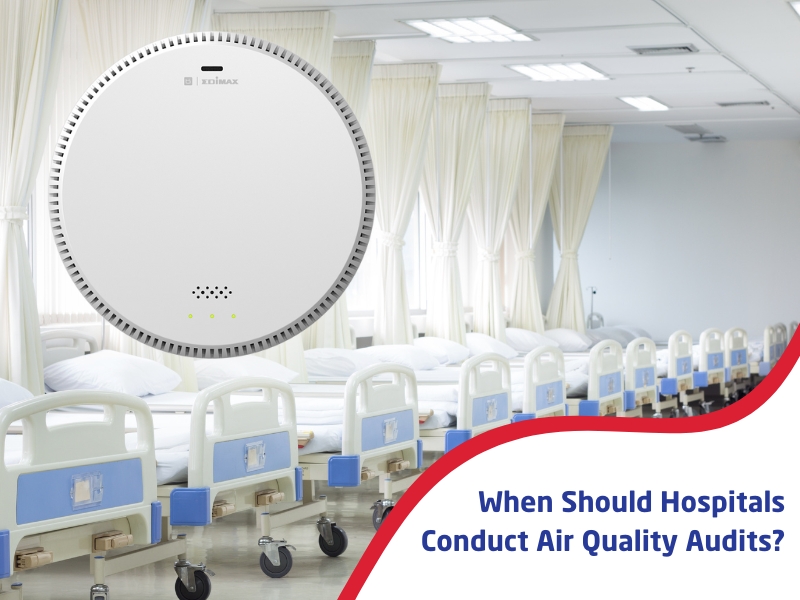Maintaining clean air is crucial in hospitals, where the health and safety of patients, visitors, and staff rely on a safe environment. Air quality audits help ensure hospitals meet the necessary standards for infection control, compliance with regulations, and overall safety. This article offers insight into when hospitals should conduct air quality audits, why they matter, and how to effectively integrate air quality monitoring into hospital systems.
Why should hospitals prioritise air quality audits?
Air quality audits are essential for hospitals to provide a safe environment for patients and staff. Poor air quality can lead to numerous health problems, including respiratory issues, infections, and the exacerbation of existing conditions. Hospitals should prioritise air quality audits to:
- Ensure patient safety: Poor air quality can negatively impact patients, especially those with respiratory conditions or weakened immune systems.
- Infection control: Airborne pathogens, including viruses and bacteria, can spread through poorly ventilated hospital spaces.
- Compliance with regulations: Hospitals must meet air quality standards and environmental regulations set by local health authorities.
- Improve staff well-being: Healthcare workers are also at risk of health problems related to poor air quality, including fatigue and respiratory distress.
According to experts, poor air quality in healthcare facilities can increase the risk of healthcare-associated infections (HAIs), highlighting the importance of regular audits.
What are the key indicators that hospitals need air quality audits?
Regular air quality monitoring is vital for identifying potential issues before they become severe. Some key indicators that suggest a hospital might need an air quality audit include:
- Increased cases of respiratory illness: A rise in staff or patient respiratory problems can indicate poor ventilation or the presence of harmful particles in the air.
- Stale or unpleasant odours: Lingering smells can be a sign of inadequate air circulation or the presence of contaminants.
- Visible mould or dampness: Mold and moisture can contribute to poor air quality and exacerbate breathing conditions, especially for vulnerable patients.
- High Humidity or temperature fluctuations: These conditions can affect air quality by promoting the growth of harmful microorganisms.
- Reduced airflow in critical areas: Intensive care units (ICUs), operating theatres, and patient rooms require optimal air circulation to prevent the spread of airborne pathogens.
Infectious diseases in Australia highlight the importance of regular air quality audits in hospitals, as poor ventilation can exacerbate the spread of these illnesses within healthcare settings.
How often should hospitals conduct air quality audits?
The frequency of air quality audits depends on the size and usage of the hospital, as well as specific areas like ICUs or operating theatres. However, the general recommendations are:
- At least annually: Hospitals should conduct a comprehensive air quality audit every 12 months to assess ventilation, filtration, and pollutant levels.
- After major renovations or construction: Any new construction or renovation work can disrupt existing air quality systems and may introduce new pollutants.
- When there are complaints or health concerns: If there are noticeable health impacts or complaints about air quality, an immediate audit should be conducted.
- In response to regulatory changes: When Australian health authorities introduce new air quality standards, hospitals should reassess their systems to ensure compliance.
Australian Standard AS 1668 provides guidelines on ventilation design, installation, and maintenance for buildings, including specific requirements for healthcare facilities to control airborne contaminants.
What are the benefits of using advanced air quality monitoring systems in hospitals?
Advanced air quality monitoring systems provide hospitals with real-time data on air quality parameters. These systems offer numerous benefits, including:
- Real-time monitoring: Hospitals can continuously monitor air quality, allowing for immediate response to deviations from safe levels.
- Data-driven decisions: Continuous monitoring allows hospital managers to make informed decisions about air quality and ventilation systems.
- Proactive maintenance: By identifying potential problems early, hospitals can schedule maintenance before issues become critical, reducing downtime.
- Regulatory compliance: Advanced systems can help hospitals meet air quality standards set by health authorities.
- Improved patient and staff health: Continuous monitoring ensures that air quality remains safe, protecting both patient health and staff well-being.

To enhance the effectiveness of air quality audits, hospitals can improve air quality with the Edimax 10-in-1 Detector, which offers real-time monitoring of key air quality indicators for a safer, healthier environment.
How can hospitals integrate air quality monitoring into their existing systems?
Integrating air quality monitoring into a hospital’s existing infrastructure can be a seamless process with the right tools. Steps to integrate air quality monitoring include:
- Choosing the Right Technology: Select an air quality monitoring system that integrates easily with your existing hospital management software and building management systems.
- Setting Up Sensors in Critical Areas: Install sensors in patient rooms, operating theatres, and other critical areas where air quality is paramount.
- Training Staff: Ensure staff are trained to interpret air quality monitoring systems data and take corrective actions when necessary.
- Regular Calibration: Regularly calibrate the monitoring systems to ensure accuracy and reliability.
- Data Analysis and Reporting: Use data collected from the monitoring systems to generate regular reports and assess trends in air quality over time.
Australian hospitals are increasingly adopting these systems to optimise air quality management and comply with national air quality standards.
What role does air quality play in infection control and patient safety?
Air quality is directly linked to infection control and patient safety in hospitals. Hospitals with poor air quality are more prone to the spread of airborne infections. Airborne pathogens, such as viruses and bacteria, can circulate through inadequately ventilated spaces, potentially leading to healthcare-associated infections (HAIs). By ensuring high air quality:
- Reduced spread of airborne infections: Proper ventilation and air filtration reduce the risk of spreading airborne pathogens.
- Improved sterilisation: Well-maintained air quality systems help hospitals maintain sterile environments, particularly in surgical theatres and ICUs.
- Increased recovery rates: Cleaner air promotes quicker recovery, especially for patients with respiratory conditions or weakened immune systems.

Understanding and managing airborne contaminants in healthcare settings is crucial for maintaining a safe environment. These contaminants can significantly impact both patient health and staff well-being. Research shows that hospitals with robust air quality management systems experience fewer outbreaks of respiratory infections, significantly improving patient outcomes.
How can hospitals ensure compliance with air quality regulations?
To ensure compliance with air quality regulations, hospitals must stay up-to-date with local and national standards, including:
- Following Australian Standards: Hospitals must comply with AS 1668, which outlines ventilation and air conditioning requirements in healthcare facilities.
- Conducting Regular Audits: Hospitals should schedule regular audits to assess compliance with air quality standards.
- Adopting Best Practices: Implementing industry best practices, such as maintaining proper ventilation in high-risk areas like ICUs, operating theatres, and patient rooms, is essential.
- Staying Updated on Regulatory Changes: Health regulations related to air quality may evolve, and hospitals must adapt to meet any new standards or guidelines.
What are the long-term cost savings of regular air quality audits?
Regular air quality audits can lead to significant long-term cost savings. By identifying and addressing air quality issues early, hospitals can:
- Reduce healthcare-associated infections: Fewer infections lead to lower healthcare costs, as patients require less extended care.
- Minimise equipment failures: Proper air quality ensures that hospital HVAC systems and other critical equipment run efficiently, reducing maintenance costs.
- Prevent legal or regulatory fines: Ensuring compliance with air quality regulations reduces the risk of fines or legal issues.
- Improve staff productivity: Healthier staff means fewer sick days and greater productivity.
Enhance your hospital’s air quality with Edimax
At Edimax, we specialise in delivering cutting-edge solutions that help hospitals effectively monitor and enhance air quality. Our 10-in-1 Multi-Sensor Indoor Air Quality Detector ensures a safe and healthy hospital environment, providing real-time monitoring with easy integration into your existing systems. One of our long-standing clients praised our team’s flexibility and dedication, noting how we’re always ready to assist with customised solutions. Whether you’re upgrading your air quality monitoring or setting up new systems, you can rely on us to create a healthier space for both patients and staff. Contact Edimax for air quality solutions that offer advanced monitoring systems, ensuring a safer and healthier environment for all.
Frequently Asked Questions
- How do I know if my hospital needs an air quality audit?
If complaints about odours, visible dust, or frequent respiratory issues occur, it’s time to conduct an audit.
- What air quality indicators are most critical for hospitals?
Key indicators include dust particles, volatile organic compounds (VOCs), carbon dioxide, and humidity levels.
- How does air quality affect patient recovery?
Clean air promotes better oxygen intake, helping patients recover faster and avoid complications.
- What are the most common air quality issues in hospitals?
Common issues include poor ventilation, mould, and cleaning agents or construction pollutants.
- Can poor air quality lead to hospital-acquired infections?
Yes, inadequate air quality can increase the risk of airborne infections and HAIs.
- What regulations govern air quality in hospitals?
Regulations vary by country but generally include standards for ventilation, particulate matter, and airborne pathogen control.
- How can hospitals monitor air quality in real time?
Advanced air quality monitoring systems provide continuous data and alerts.
- What are the costs of conducting an air quality audit?
The costs vary depending on the size of the hospital and the complexity of the audit, but they are an investment in long-term savings.
- How often should hospitals replace air filters?
Air filters should be replaced regularly, typically every 3-6 months, depending on usage and air quality levels.
- What is the role of the HVAC system in air quality audits?
The HVAC system plays a critical role in maintaining air quality. Audits ensure it is functioning efficiently and meeting safety standards.
- What is the cost of an air quality audit for a hospital?
The cost varies depending on the hospital’s size and complexity, but it invests in long-term savings and improved safety.
